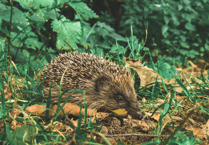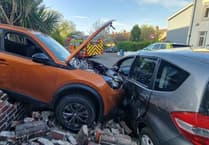A memorial service has been held in Andreas to mark the 80th anniversary of a WWII plane crash which took the lives of two RAF servicemen.
The accident aircraft, a Fairey Battle light bomber, was used at RAF Jurby to tow fabric ’drogue’ targets off the island’s northwest coast where they were used for gunnery practice by other bombers.
The memorial service was attended by 97-year-old Andreas resident John Crellin, who witnessed the crash in 1940 as a 17 year old and helped to recover one of the bodies from the wreck.
Speaking at Thursday’s memorial service, which was held in the exact spot where the crash happened, Mr Crellin said: ’I was off school at the time owing to an illness at college which enabled me to stay home for a day or two.
’The weather was dry and sunny, and I was looking for bait from the nearby ditch for the Ballachurry fish pond.
’I found nothing and was returning up the lane to my bike when I heard the engine of an oncoming Fairey Battle cut, while on its way from Close Lake aerodrome where I assumed it had dropped its drogue target for a count of new bullet holes.
’The aircraft with the failed engine emitted a cloud of white smoke and started a shallow dive at a fairly low altitude.
’As I was close to the top of the road I saw the aircraft - it seemed to be coming directly towards me with a hedge on either side.
’Within seconds the aircraft rolled on its back and penetrated the field with a thud.
’The tailplane remaining pointed to the school at St Jude’s at about 45 degrees out of plumb. I did not notice a tow line coming from the aircraft, though there may have been one.
’I climbed through the hedge to the aircraft, everything was silent.
’There was a strong smell of aviation petrol in the area.
’I kept away from the wreck to start with, in case of sparks or fire.
’Where the leading edges of the wings were buried in the soil I noticed small "volcanoes" with black smoke, and concluded that the fuel tanks had fractured in the impact.
After a short while I was joined by Mrs Mitten, an adjacent householder, who also noticed an RAF blue jacket inside the canopy and wanted to investigate.
’We did so when the area cooled.
’We broke our way into the canopy to the drogue operator and found him face down.
’His tunic was soft and warm and I thought that he was still alive.
’But on examination he was found to be a little lad of about my age with white skin and blue eyes.
’I was confident that he had been killed instantly by the impact.
’We laid the body out on the ground beside the fuselage, and covered him with his parachute which had been deployed inside the canopy.
’We decided that we could do nothing to help recover the pilot, which would require special equipment.
’He was a Pole who was later buried at RAF Jurby.
’As an observer of this incident I was asked to attend the inquest at RAF Jurby, after which two officers thanked me for my help.
’The younger one, the pilot of a fighter with similar engines and equipment to the Fairey Battle, mentioned that the provision of excessive boost could cause engine failure.’
The crew of the Fairey Battle light bomber were pilot Sergeant Stanislav Osmala and Aircraftsman 2nd class Arthur Sharp.
Reverend David Greenwood led Thursday’s memorial service, reading an RAF prayer and verses of poetry.
Mr Crellin was also presented with a small piece of wreckage by a local farmer Alan Radcliffe, who had discovered it in a recently ploughed field where the crash site had been.
The piece found was a serial number plate for the aircraft’s carburettor, discovered by Mr Radcliffe as it was in almost perfect condition.
Reflecting on what happened in that same field 80 years ago, Mr Crellin added: ’To have it crash right beside me, yes that was quite a shock.
’It’s interesting to see this field again and think of the events that happened in it.’
Asked if he thought it was important that such tragedies continue to be commemorated today, he said: ’ I think it is important, yes.
’Because these crashes were occurring relatively frequently, you see.’
A Royal Air Force station operated at Jurby from 1939 to 1963, and during the war was home to operational squadrons as well as being used for training - with fatal training accidents being a common occurrence.
There was also an operational station in Andreas, RAF Andreas, which was in use from 1941 to 1946.




.jpeg?width=209&height=140&crop=209:145,smart&quality=75)
Comments
This article has no comments yet. Be the first to leave a comment.